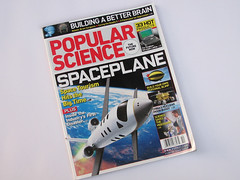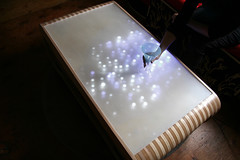 Cool, our interactive LED coffee tables got a mention in the October issue of Popular Science!
Cool, our interactive LED coffee tables got a mention in the October issue of Popular Science!
What’s an interactive LED coffee table? (Funny you should ask….) It’s a coffee table that has hundreds of LEDs in the top surface that respond to motion above the table. We have (finally) put together a movie to give you a better idea of how they respond to their environment. You can see the movie on YouTube or watch it embedded:
The complete tables are for sale from Because We Can, our partners in design on this project. There are presently two models, The Ripple (left) and The Wave (right):
Since we first showed these off, we have had a lot of inquiries about how you can make your own table like this. We are now producing (very large) electronic soldering kits so that you indeed can make your own.
Our kits include the giant printed circuit boards, components, instructions, LEDs, and all other parts needed to build the electronic portion of the table tops. Constructed, you end up with what essentially amounts to a single extra-ginormous circuit board that can sit underneath the clear or frosted glass (or plastic) top of your own table. Interesting in getting a kit? Click here to read the details!
(Revised 11/16/2007).






It’s nice to see the tables in action. I have been curious as to how they look while operating. Nice work, Windell.
—
– Creech
It’s very, very hard to record the action of the tables in a way that reflects your eye’s experience. The chief problem is one of dynamic range; our eyes can see things over a much wider range than the CCD can. I’m still profoundly unsatisfied with how the tables come across in the video… Up until now I’ve been debating whether it was better to post this or to post nothing at all. It’s a tough call. We lose subtlety, responsiveness, and color definition. It’s a tough call indeed.
—
Windell H. Oskay
drwho(at)evilmadscientist.com
http://www.evilmadscientist.com/
Wow! This is an awesome! I think it would be super cool to put this in a storefront window and let people play with it at night. – Bre
this would be a good beer pong table
I’ve coveted these forever, but we had a coffee table, and they were too expensive. We’ve found a home for our coffee table, so now I’m rethinking. Is size the only difference between the Ripple and the Wave – not the behaviour? (I feel like I’m discussing condoms, for some reason)
would this work mounted on a wall?
The panels would work very well as a wall display– I probably should have mentioned that as a good application. The only thing to be careful about is to make sure that they are securely attached to a sturdy surface; the board-to-board connections do not provide mechanical strength.
—
Windell H. Oskay
drwho(at)evilmadscientist.com
http://www.evilmadscientist.com/
would this work mounted on a wall?
Your coffee’d fall off…
Bravo!
—
Windell H. Oskay
drwho(at)evilmadscientist.com
http://www.evilmadscientist.com/
Silly question, but have you tested this with frosted glass? While the PCBs are gorgeous, the wife doesn’t share my geek aesthetic :)
Yes, it looks better (IMHO as well) with frosted glass; it just tends to be damned expensive, that’s all. ;)
The tables that BWC sells are available with a sanded plastic top as a standard option; that works very well. The picture of the “ripple” table lit up with a martini glass on top has that surface– you can see some pictures of how that looks here.
—
Windell H. Oskay
drwho(at)evilmadscientist.com
http://www.evilmadscientist.com/
Use LEDs as your photo diodes, then use a diffusing finish, or sandblast some design into the glass and you have something a bit cooler.
Jeff Han’s LED sensor
Paper on LEDs as Diodes
Our current sensors are visible-blocking IR phototransistors that enable the active IR sensing so that the tables still work in the dark. They aren’t expensive.
We already have frosted tops as a standard option on our tables– and if you use a kit, you can use whatever design you want on the surface.
—
Windell H. Oskay
drwho(at)evilmadscientist.com
http://www.evilmadscientist.com/
hey man nice job on this. I do plan to buy this myself but do u have to use it just for a coffee table or can it be sumthing else
It would look good as wall art. Some differences in how you might want to mount it, but that’s it.
—
Windell H. Oskay
drwho(at)evilmadscientist.com
http://www.evilmadscientist.com/
———————-> MUST SEE:
Would make a cool wall…
Two quick questions:
Are the edge connectors okay (electrically) if you join them cube-wise? This reminded me of AdaFruit’s Conway Life boards, which can be bussed into a cube. http://www.ladyada.net/images/conway/cubetest2_t.jpg (I can work out the connectors if the circuit doesn’t mind this arrangement.)
It would also be neat to arrange the lights on each panel in a slightly less boxy, more organic way. Like the arrangement pattern of the yellow "20" symbols on the back of a 20 dollar bill. Or make a hexagonal PCB for your next design…
They can be electrically connected in a cube. Mechanically, that might be a bit of a challenge.
As far as the LED arrangement goes, we initially had them in a somewhat scattered pattern that did not look like a grid. And people kept asking why we didn’t make them in a grid. So we changed them to a grid. And now people keep asking why we put them in a grid. Go figure.
—
Windell H. Oskay
drwho(at)evilmadscientist.com
http://www.evilmadscientist.com/
Well…i’d be afraid to spoil coffee on such a table, it is to great for hot drinks, thats more for fun, but to have a cup of coffee better use these devices
Absolutely beautiful.
Is there any way we could get the schematics for this table? I know you released the schematic and a rough guide for the dining room table, but I’m pretty certain that this is a different circuit altogether. A schematic release similar to the one for that table would be much appreciated!
If, by schematics, you’re looking for a circuit layout, there is a history behind the electronics that are used for the coffee table, inasmuch as they’re not Open Source like a number of the other schematics for other projects from EMSL. If you’re interested in building a table similar to this, you will most likely just need to use the Interactive LED Panels, available either pre-assembled or as a soldering kit from the Evil Mad Science Store.
Pre-assembled:
[link:]http://evilmadscience.com/majors/46-tables
Soldering Kit:
[link:]http://evilmadscience.com/majors/150-panelkits
Note that the pre-assembled kits are backordered, and there appears to only be one soldering kit in stock right now.
Also, note that the Coffee Table panels use microcontrollers for most of their work, and the source code is also not open-source.
The Coffee Table is to the Dining Table like the Larson Scanner Kit is to the Cylon-o-Lantern; the Larson Scanner Kit uses a micro-controller, which makes it more versatile and less power-hungry, while the original Cylon-o-Lantern used a 555 timer to do its thing.
Actually the coffee table uses an analog circuit that’s very similar to the dining table circuit. We do have some digital things in the works– like the ones that we’ve used for our "game of life" display, however.
Windell H. Oskay
drwho(at)evilmadscientist.com
http://www.evilmadscientist.com/
That’s what I get for not buying one, I suppose… :(
mea culpa
*embarrassed*
You mentioned that you performened extensive simulations on the circuit. I was curious to know what CAD program you used? Right now I am useing B2 Spice, would you recommed something different?
We’ve used LTspice.
Windell H. Oskay
drwho(at)evilmadscientist.com
http://www.evilmadscientist.com/
Hi everyone. In this project you use phototransistors and ir leds as sensor, am i right? I want to know that how this system works behind the frosted glass. i think the ir light reflect from frosted glass and phototransistor or photodiode effect from this light. Also ir light reflect from a normal glass but your system is work very well behind the normal glass or frosted glass. How?
And the other question; does this system work in pitch-dark enviroment. Can you explain.
Thank you.
is there anybody who can answer this question?
Have you read the original article at http://www.evilmadscientist.com/article.php/ledcoffee, where it’s all explained?
And the article about their first one: http://www.evilmadscientist.com/article.php/LedDiningTableStory